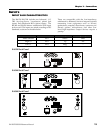
Connections: Chapter 2
18 RA150/300/500 Reference Manual
OUTPUTS
Warning: Be sure that the AC power is off prior
to connecting or disconnecting any signal
wiring.
WHAT'S THE LOAD IMPEDANCE?
Alesis amplifiers can reliably drive 4 Ω loads in
Stereo mode and 8 Ω loads in Bridged Mono mode.
However, the impedance of a loudspeaker varies
with frequency, and its nominal rated impedance is
not necessarily its minimum impedance. Some
loudspeakers carry both nominal and minimum
impedance specifications, and some are supplied
with impedance curves. When connecting multiple
loudspeakers or systems to any amplifier, care
should be taken that the actual load impedance does
not drop below the amplifier’s rated output load.
The RA150/300/500 amplifiers will not be damaged
by excessively low output load impedances, but
they will not be able to provide full output power
and their protection circuits may automatically cut
off their outputs until the low load condition is
removed.
CONNECTORS
Each channel features a standard binding post
connector (red = “hot” output, black = ground).
The binding post or "banana" connectors are the
preferred choice for permanent installations. There
is greater surface area contact than with phone
connectors, thus promoting a better electrical
connection between the speaker wire and amplifier.
SPEAKER CABLES
The cables you use between the RA150/300/500
and its speakers are very important. Speaker cables
must deliver large amounts of peak current to a
speaker. To complicate matters further, a speaker
represents an inductive load, and is more difficult to
drive than a purely resistive load. Speakers are also
very low impedance devices. Any resistance
between the amp output and speakers will degrade
the damping factor, efficiency and ultimately, the
sound quality.
Alesis recommends stranded, rather than solid,
cables for flexibility and ease of installation.
However, solid cables are equally usable.
Never use shielded guitar cords as speaker cables.
Because they lack sufficient current-carrying
capacity, the amp and speakers will not perform
properly and the sound may be degraded.
If you make your own cables, use electrical zip cord,
which is designed to handle several amps of
current, or heavy-gauge speaker cables if possible.
In any event, the thicker the cable, the lower the
resistance and the better the current-carrying
capability. Thin hookup wire is not acceptable; the
minimum acceptable wire type is the common “zip
cord” used to connect AC to appliances. The table
below relates the wire gauge to the how many feet
of cable will lead to a 1 dB power loss at different
impedances. The lower the resistance, the better.
For cables run up to about 25 feet, 16 to 18 gauge
wire is satisfactory.
Cable length that produces 1 dB of power loss
at 4Ω at 8Ωwire gauge
feet meters feet meters
6 1200 366 2425 740
8 800 244 1600 488
10 475 145 950 290
12 300 91 600 183
14 190 58 375 114
16 120 37 240 73
18 75 23 150 46
20 50 15 100 30
22 30 9 60 18


















